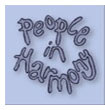|
Intermix.org.uk is a website for the benefit
of mixed-race families, individuals and anyone who feels they have a multiracial
identity and want to join us. Our mission is to offer a view of the mixed-race experience, highlighting icons, film, books, poetry, parenting techniques, celebrities, real lives and much more. Our online forums are a great place to meet others, ask questions, voice your opinions and keep in touch. Sign up for our monthly newsletter and delve into our pages. Want to join in? Become an Intermix member to take part: |
People In Harmony
Jill Olumide

People in Harmony is a charity that has been active for some 35 years. It was formed as a self help group to offer a refuge to mixed race families and mixed race people from the onslaught of the politics of the time (the heyday of Enoch Powell) when the race card was often played with reference to the perceived unnatural and inappropriate (if not distasteful) practise and outcomes of race mixing. This was not necessarily a new approach to perceived race mixing (as older members recall), however, perhaps the increase of New Commonwealth invitees (and the poor preparation for their welfare needs) and inevitable mixing with neighbours and workmates offered a sitting target.
Since then, politics and life in the UK have progressed. However, throughout this time there have been differing issues to be met within the mixed race community (if such a community exists), and successive groups have looked to the charity for support and information. People in Harmony has always been a volunteer led organisation and still operates without any serious funding, although this situation is increasingly a problem if it is to develop and continue to offer a range of services. Need has not diminished, it has simply altered course over the years.
For the charity, the exclusion of a mixed race sensibility in areas of policy and professional practice has appeared to form the basis of many 'real life' problems. It is for this reason that the trustees, within the limits of their capacity, have been keen to offer support to people researching different areas of mixed race experience. Many of us who are researchers will understand that there are few sources through which a mixed race research population can be contacted. People in Harmony is able to facilitate such contacts through its membership and website, and has a broad access to a population which has self-defined itself and its interests as falling within a definition of 'mixed race' (the term 'racialised as mixed' is perhaps more accurate than 'mixed race' in finding the root of many an experience).
An example of this interest in research was the 2005 annual conference. There had been some notable research suggesting that mixed race children are generally not well catered for in schools. We were already aware of issues such as mixed racism in schools and the poor representation of mixed race families and children in children's books and these matters had already been addressed at previous events. In 2005 Chamion Caballero, Suki Ali and others with research, or other interests to share, were invited to take the platform and discuss their work concerning mixed race and education. A conference report was produced with the help of the Zeena Ralph Memorial Fund and is now available from the charity. In addition, a synopsis of the research evidence was made available and a letter campaign undertaken amongst politicans and LEAs both to make them aware of the situation and to enquire into what was being done to address the question of mixed race children in schools. The response has not been greatly encouraging.
As research interest in mixed race matters grows, other areas of neglect or misperception emerge. This year the charity has taken the theme of health for its study conference. Although there seems to be little direct research on mixed race and mental and physical well-being underway, the last census (as well as other big surveys) offers insights into the health of the mixed race population, but this also appears to be an area in need of further investigation. So too does the criminal justice system, where those wishing to identify as mixed and have their sensibilities respected often have limited opportunities.
Social services is an area of some long standing concern and has been a source of 'unusual' practice, not just in the disproportionate numbers of mixed race children in the public care system and the apparent lack of consultation available about identification, but in the statements publicly issued surrounding the 'oughts' of mixed race families more widely. People in Harmony offers space to all parties in the adoption process to explore their experiences, and makes no judgement about the 'rights and wrongs' of so-called transracial adoption and fostering. Adoptees, for example, sometimes explore what is often a position of ambivalence over their experiences through the charity's newsletter and web pages. In a very similar manner, members have explored their journeys to find 'lost' aspects of their parental make up and describe meeting up with families absent during their formative years. Until quite recently, space to unpack these life experiences, let alone to compare them with similar lives, has been very limited.
Sometimes families, as well as 'professionals' and institutions, are a source of oppression both to mixed race people and to their parents. Absent parents, denying contact, rejecting parents who refuse contact with mixed race partners and children, and families in outright opposition who wish to prevent marriages or liaisons from taking place all cause a weakening in the defenses of mixed race families and seem to cause all parties (but particularly the children, once independent) to pause, at a suitable moment in their lives, to attempt to recoup the 'lost' aspects of themselves and to examine meanings of suppression. Even within mixed race families, opportunities to reflect and to define selfhood are sometimes restricted. These (and many other) unique aspects of mixed race experience need to be understood more widely and space needs to be made within policy and practice.
There needs to be caution in 'fixing' knowledge about the mixed race community (and as so often seems to be the case, about all groups of people). There can be no development of 'experts' professing stereotypical view of mixed race allowed. We have seen the difficulties which this causes in social services in recent decades. Miri, in her paper, suggests that there is no 'one size fits all' view of mixed race, and this is quite right (and not just for mixed race). However there are patterns, in particular those settling around class and gender. For example the experiences of single parents of mixed race children appear to be influenced by gender as well as perceived ethnicity, with white mothers finding both professional and societal disapprobation often to be acute and destabilising. Whilst it may be difficult to identify a 'mixed race community' because of the differences in background and class, this must also be true of 'the black community' or the 'British People'. Yet there are traces of recognition to be found, familiarity of faintly yet recognisably shared experiences, some common ground.
In the area of class, a piece of research into probation and race (1) identified a sub group of offenders who doggedly refused to be classified under any of the ethnic labels available to them and insisted the researchers used variants on the 'mixed' theme when referring to them. It was then possible to identify, during analysis, that this 'mixed' group had the worst record of school exclusions and attainment of qualifications, were least likely to have been able to secure work, had higher levels of poverty, drug and alcohol consumption, were most likely to have spent time in care and other adverse markers than other ethnic categories. It is difficult to say how widespead this pattern is amongst the poorest people in the mixed race group in our society, particularly from a piece of research that had not set out to investigate mixed race in particular. However, when included with other information such as school exclusions, self reported health and access to decent work, it becomes pressing to investigate links between mixed race and social class. Whilst the well educated and more privileged members of the UK mixed race 'community' are free to explore, like their US cousins, their individual responses to being mixed race, there are many against whom the odds seem to be stacked.
This seems to be one of the ambiguities of mixed race experience - whilst there are those for whom privilege has (historically) been an experience and who contend with issues such as ambivalence, 'brown guilt' and creatively exploring their experiences, there are others who receive disproportionately negative experiences and appear, in consequence, to be particularly disadvantaged - more so than those in 'monoracial' groups.
It seems to be to this section of society that the attention of politics and policy must turn. Not with a view to organising and regulating (as has sometimes happened in the past) but to seeking to identify the social causes of disadvantage through serious investigation and consultation. One example of an attempt to address these concerns has been Simon Barth's work in Sheffield with mixed race children from mainly poor backgrounds in an attempt to build their confidence and self esteem. At the 2004 People in Harmony annual conference he shared some of the issues facing the children and the work being done to restore faith in themselves and their lives. Old questions of negative and acceptable terminology for mixed race were raised, and this seems to be a perenial question that is never quite resolved to everyone's satisfaction. This seems to be indicative of the many ways in which mixed race and race mixing is portrayed and a general ambivalence engendered around the whole question. In itself this ambivalence requires serious analysis.
A survey of People in Harmony members is currently being undertaken to compliment the charity's existing information. Although many wants and interests have moved on from the early days when there was an emphasis on physical meeting and information sharing, a primary response is still a desire to meet or to be put in touch with others in mixed race partnerships or with other mixed race people. Although there are many dissimilarities in ethnic make up, class, occupation and sexuality, there is none the less an apparent desire to identify and be in touch with others associated with mixedness. This may be a very loose underpinning for a community, but it is certainly a source of affinity and belonging.
However we may believe ethnic groups take form, the persistent social definition 'racialised as mixed' does appear to create a certain commonality of experience to be addressed and, increasingly, performed. However, before there is any rush to policy, some of the profound questions around the shaping of mixed race experience must be unravelled. In this area of social life there is definitely a 'more research needed' sign over the door. A first question must surely be why some people come to be racialised as mixed whilst others are considered to be pure.
This paper is taken with kind permission from the forthcoming Runnymede Trust publication: Mixed Heritage: Identity, Policy and Practice.
Reference
(1) Lewis et al. (2006)
Bibliography
Ali, S. (2003) Mixed-Race, Post-Race: Gender, New Ethnicities and Cultural Practices, Oxford: Berg.
Lewis,S & J. Olumide. (2006) "Not black and white: mixed heritage experiences of criminal justice." In: Lewis, Raynor, Smith & Wardak (Eds.), Race and Probation. Cullompton: Willan
Tikly, L., Caballero, C., Haynes, J. & Hill, J. (2004) Understanding the Educational Needs of Mixed Heritage Pupils, London: Department for Education and Skills.
